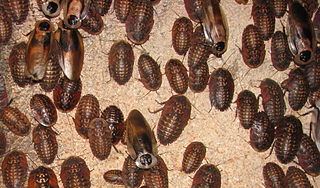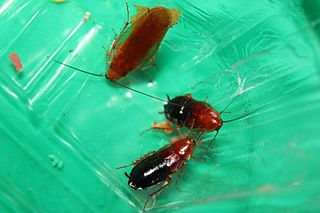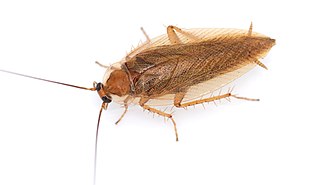
Giant cockroaches, or blaberids, are the second-largest cockroach family by number of species. Mostly distributed in warmer climates worldwide, this family is based on the American genus Blaberus, but much of the diversity is also found in Africa and Asia.

The American cockroach is the largest species of common cockroach, and often considered a pest. In certain regions of the U.S. it is colloquially known as the waterbug, though it is not a true waterbug since it is not aquatic. It is also known as the ship cockroach, kakerlac, and Bombay canary. It is often misidentified as a palmetto bug.

Ectobiidae is a family of the order Blattodea (cockroaches). This family contains many of the smaller common household pest cockroaches, among others. They are sometimes called wood cockroaches. A few notable species include:

Parcoblatta fulvescens, the fulvous wood cockroach, is a species of cockroach endemic to the United States and possibly Canada that measures around 13 mm (0.5 in) long.

A tegmen designates the modified leathery front wing on an insect particularly in the orders Dermaptera (earwigs), Orthoptera, Mantodea, Phasmatodea and Blattodea (cockroaches).

Blattodea is an order of insects that contains cockroaches and termites. Formerly, termites were considered a separate order, Isoptera, but genetic and molecular evidence suggests they evolved from within the cockroach lineage, cladistically making them cockroaches as well. The Blattodea and the mantis are now all considered part of the superorder Dictyoptera. Blattodea includes approximately 4,400 species of cockroach in almost 500 genera, and about 3,000 species of termite in around 300 genera.

Cockroaches are insects belonging to the order Blattodea (Blattaria). About 30 cockroach species out of 4,600 are associated with human habitats. Some species are well-known pests.

The giant burrowing cockroach is also known as the rhinoceros cockroach, and Queensland giant cockroach. These cockroaches are native to Australia and mostly found in tropical and subtropical parts of Queensland. They are the world's heaviest species of cockroach and can weigh up to 30-35 grams and measure up to 7.5-8 cm (3.1 in) in length. It is a member of the family Blaberidae, which contains hundreds of species. It is part of the blaberid subfamily Geoscapheinae. It is prominent in the wild and can also be sold and kept as a pet.

Blaptica dubia, the dubia roach, orange-spotted roach, Guyana spotted roach, or Argentinian wood roach, is a medium-sized species of cockroach which grows to around 40–45 mm (1.6–1.8 in).

Therea petiveriana, variously called the desert cockroach, seven-spotted cockroach, domino cockroach, or Indian domino cockroach, is a species of crepuscular cockroach found in southern India. They are members of a basal group within the cockroaches. This somewhat roundish and contrastingly marked cockroach is mainly found on the ground in scrub forest habitats where they may burrow under leaf litter or loose soil during the heat of the day.

Eublaberus distanti, known as the Six-spotted cockroach, Four-spotted cockroach, Four-spot cockroach, or Trinidad bat-cave cockroach, is a primarily cave-dwelling Central and South American cockroach of the genus Eublaberus and named after William Lucas Distant.

Cariblatta lutea is a small species of cockroach native to the United States and other countries, measuring usually around 7 millimeters long as an adult and under 2 millimeters from head tip to abdomen tip at the 1st instar or hatchling. It consists of two subspecies, the small yellow cockroach, and the least yellow cockroach.

Parcoblatta bolliana, Boll's wood cockroach or Boll's wood roach, is a small species of wood cockroach native to the United States, measuring around 11 mm (0.43 in) long.

Parcoblatta uhleriana, the Uhler's wood cockroach, is a species of Parcoblatta native to the United States and Canada. It is a forest species also found in disturbed and urban environments. The male of the species flies freely, while the female does not fly.

Parcoblatta lata, the broad wood cockroach, is a species of wood cockroach native to the United States. It is one of the largest species of wood cockroaches.

Parcoblatta caudelli, Caudell's wood cockroach or Caudell's wood roach, is a species of cockroach native to the United States.

Parcoblatta americana, the western wood cockroach, is a species of wood cockroach that occurs in Mexico and the western United States.

Ectobius vittiventris, the amber wood cockroach or amber forest cockroach, is a species belonging to the order Blattodea and is a type of wood cockroach originally from southern Europe. It is completely harmless to humans and is not a storage pest, as it only feeds on decomposing plant material and perishes within a few days in human dwellings due to a lack of food. Its original range was south of the Alps, but is now permanently established north of the Alps and in southern Germany.

Schizopilia fissicollis is a species of cockroach living in Suriname and French Guiana.


















